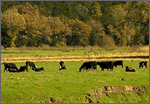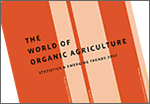|
|
|
 |
 |
 > What is Organic Farming? > Organic Livestock > Some Figures dimarts, 22 de maig de 2007
Recent years have seen a remarkable growth in organic farming, helped by an increasing awareness of environmental concerns and of food safety.
In the European Union, for example, organic agricultural production increased by 25% (between 1993 and 1998), and then by 30% (from 1998 to date), although this trend is stabilising in some member states. European institutions are promoting organic farming, which has been regulated for some time. The first regulations were introduced in 1991 and the most recent ones came into force last year. In Catalonia, there were 182 organic producers (farming 4,994 hectares) a decade ago compared with 722 today (farming 55,355 hectares). In 2006, 30,797 hectares in the Valencian Country were organically farmed with the corresponding figure for the Balearic Islands being 18,840. Of course, there has also been in increase in the number of people employed in preparing and selling organic produce. Having said that, it should be mentioned that the amount of land that is farmed organically is comparatively small with organic products being more expensive, although more demand and technological innovations are expected to lead to lower prices.
What is Organic Farming?Organic farming is based on the use of natural products and natural-cultivation techniques to contribute to environmental conservation, ensuring the fertility of the soil and improving product quality. A number of techniques are used such as crop rotation, crop mixing, organic fertilisers (manure, crop residues, etc.), integrating agriculture and livestock, and avoiding the use of chemical fertilisers and pesticides, growth hormones, antibiotics and genetically modified organisms (GMOs) -also known as transgenics.
Organic Livestock
+ Organic meat production demands taking animal welfare into consideration.
Organic farming does not just include agriculture but also covers the production of organic meat. Organic meat production demands taking animal welfare and the health of the animal into consideration. This includes having well-maintained farmyards, poultry yards and pens, etc., a balanced diet (foraging, good quality fodder, etc.), based on organic produce, and a preference of natural medicine to treat sick animals. Finally, livestock must be indigenous species or well adapted to local conditions.
Some Figures
+ Organic farming is practiced in more than 120 countries.
According to data published by the statistical publication 'The World of Organic Agriculture',' organic farming, which is experiencing rapid growth, is practiced in more than 120 countries and covers almost 31 million hectares, accounting for 0.7% of agricultural land in the world. Australia has, by far, the largest area of organically farmed land (mostly made up of pastures), followed by Argentina and China, although the most significant growth is taking place in Europe and North America, with the United States, Poland and Italy exhibiting the fastest growth. Italy is the world's leading producer of cereals, citrus fruit, olives and grapes, with Mexico topping the table for coffee and tropical fruits. The Dominican Republic is the leader in terms of organic cocoa production, Turkey in cotton production and Thailand in rice cultivation.
|
Investiga
I també...
- La producció mundial, en gràfics.
- La certificació ecològica.
- Què en sabeu, de la producció integrada?
Portada |
Europa Press |
El Punt |
La premsa |
Especials |
Diari de l'escola |
LesFinances.info |
Editorials |
Mail obert |
Els blocs |
Lletres
Tecnologia i ciència | Solidaritat | Cap de 7mana | Campus | El 9 | Presència | Fòrums | Enquestes | Xat | Correu
Traductor | Edicions en Pdf | Wap-pda | Biblioteca | Lletra més grossa
Tecnologia i ciència | Solidaritat | Cap de 7mana | Campus | El 9 | Presència | Fòrums | Enquestes | Xat | Correu
Traductor | Edicions en Pdf | Wap-pda | Biblioteca | Lletra més grossa
| Què és VilaWeb? Publicitat Mapa web Contacte | Una web de Partal, Maresma i Associats, S.L. |






